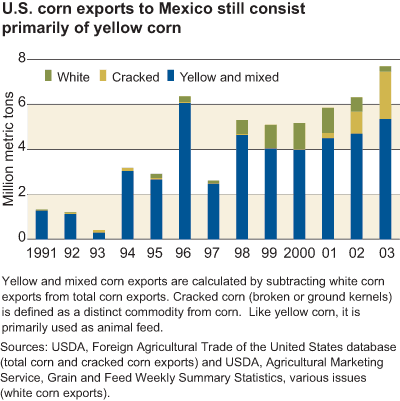Mexico's Corn Industries and U.S.-Mexico Corn Trade
- by Steven Zahniser and William T. Coyle
- 6/1/2004
U.S. corn exports to Mexico have increased dramatically since the implementation of the North American Free Trade Agreement (NAFTA) in January 1994. Most of the increased trade has been in yellow corn, used primarily to feed livestock. But over the past 3 years, about 10 percent of this trade has consisted of white corn, which is used to produce tortillas and other traditional Mexican foods.
There are two fairly distinct markets for corn in Mexico: yellow corn for livestock feed and other industrial uses, such as the production of starch and high-fructose corn syrup, and white corn for direct human consumption. Over the next decade, the growth of yellow corn exports is largely assured by the anticipated expansion of Mexican livestock production. Prospects for white corn exports are more difficult to predict, given the changing structure of Mexico’s corn, milling, and tortilla industries.
The Mexican corn sector is mostly devoted to the production of white corn. It continues to feature a large number of very small production units, typically about 10 hectares (25 acres), marked by low mechanization and low yields. Corn production has remained fairly stable during the NAFTA period, in part due to Mexican agricultural supports.
Roughly 45,000 tortilla producers and 10,000 corn millers operate throughout Mexico. But 90 percent of corn flour production is concentrated in two of Mexico’s largest food companies, Gruma and Grupo Minsa. Gruma also produces tortillas and tortilla-manufacturing equipment and has subsidiaries in Central America, Europe, the United States, and Venezuela. Gruma’s U.S. operations accounted for 47 percent of corporate sales in 2002.
Pressures for change come from both the supply and demand sides. Increased concentration of Mexico’s corn milling and tortilla industries is likely to narrow the opportunities for small-scale producers to market their output. At the same time, a shift in Mexican diets toward greater meat consumption and away from traditional foods is likely to limit the growth of white corn demand.
Income growth will not only drive changes in food demand, but it will also leverage structural change in Mexican agriculture. Improved nonagricultural job opportunities will draw some producers out of farming while supplementing the incomes of other farm households. The extent to which economic growth boosts tax revenues also may influence the degree to which the Mexican Government supports its agricultural producers. For U.S. exporters, these factors will likely assure Mexico’s position as an important and growing market for yellow corn, while export possibilities for additional white corn sales are more difficult to project.
This article is drawn from:
- Zahniser, S. & Coyle, W.T. (2004). U.S.-Mexico Corn Trade During the NAFTA Era: New Twists to an Old Story. U.S. Department of Agriculture, Economic Research Service. FDS-04D-01.


